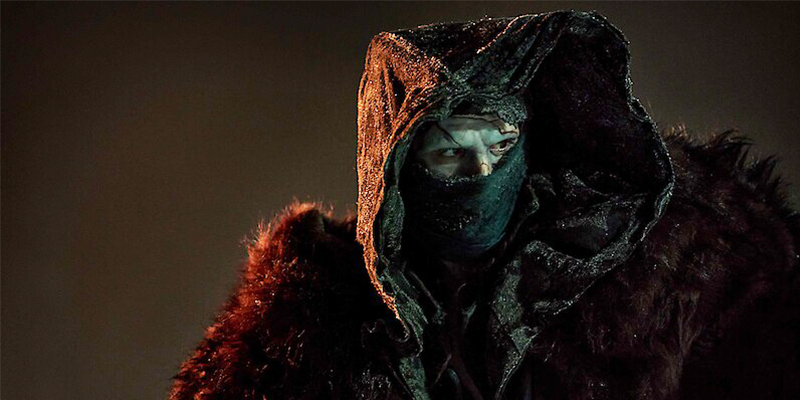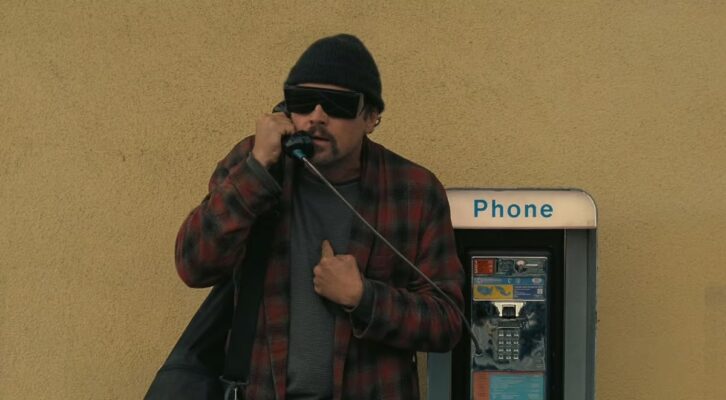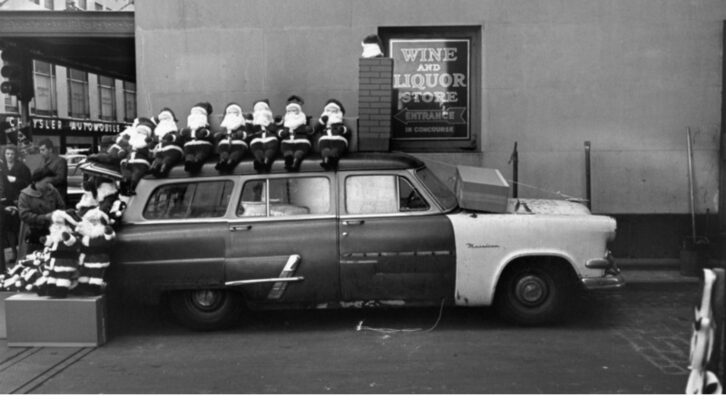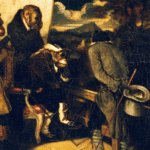One of the most recognizable words in our modern culture is “Frankenstein.” But in Guillermo del Toro’s magnificent new adaptation of Mary Shelley’s 1818 novel, another name (rather, the other part of that name) is much more important: “Victor.”
This is the name our protagonist scientist uses throughout the movie, the name everyone calls him. His hardly-spoken last name serves to connect this version of the story to its illustrious source text and rich adaptation history: most notably, the string of horror movies from the 1930s starring Boris Karloff or Glenn Strange, the Hammer films of the 1960s starring Christopher Lee, and Frank Darabont’s screenplay for Kenneth Branagh’s 1994 film version. These are all clear inspirations for del Toro, and his film pays homage to all of them. But amid all the incarnations and inspirations that the name “Frankenstein” unlocks, the name “Victor” is the key to the film’s heart.
Del Toro treats his Creature with love and tenderness, even more than Shelley does in her novel; he makes the Creature’s first word (and only word, for a while) “Victor,” the way a child might repeat “mama” or “dada” once it realizes it can refer to its protector with a name. Del Toro, who has written and produced this film in addition to directing it, deftly reads Shelley’s text as a story of parental abandonment, building out a wider story of parental abuse and neglect, emphasizing the tragic dehumanization and alienation that the Creature experiences after being forced into existence. That “Victor” means so much to the Creature even while “Victor” imprisons him, beats him, experiments on him, and tries to destroy him contains the thesis of the film. Del Toro bifurcates his version as Shelley does her novel, with each man getting to tell his story, but the whole movie, in effect, is a requiem for the Creature, who is governed above all else, by the desire to love and be loved in return.
The film begins, as the novel does, with a frame narrative: a crew of sailors on a ship stuck in ice near the North Pole rescue a weak man from cold. He is Victor Frankenstein (a brusque Oscar Isaac), and he is being pursued by an enormous, mysterious being in a cloak and hood, who (and this is the film’s first departure from the novel, though it works), arrives at the ship, bellowing to the sailors to give the dying man over to him. When they refuse, this stranger attacks the ship, repelling the shower of bullets, and managing to climb on board the vessel. In a brief break from the monster’s attacks, Victor tells the sailors the story that has led to this moment, this fiery confrontation on the glaciers of the frozen North.
Personally, I love this element of Shelley’s original novel, and del Toro’s preservation of this element helps his movie feel invested in the time period in which it’s set. Del Toro is a consummate scholar of the 19th century, and he doubles down on this setting—moving Shelley’s story up half a century to span the 1830s-50s. Shelley’s novel was written in 1816-1817 and was very ahead-of-its time, but still contains hallmarks of the early century’s Gothic movement, a far more abstract, ethereal, and theoretical period than the highly industrialized Victorian period (which ran from 1837-1901) that saw an investment in the kind of inventions that Shelley’s novel foresaw. She might have heard of the electro-experiments of the Italian scientists Luigi Galvani and Giovanni Aldini, the latter of whom electrocuted the dead body of the criminal George Foster after he was hanged at Newgate prison in 1803, when she was five years old, and expanded on them through fiction, when she was older.
Del Toro keeps many of the novel’s Gothic sensibilities (including the dank, foggy laboratory-castle in Geneva where Victor builds his monster), but with its new temporal setting, also literalizes many of these themes—capitalizing on the relevant scientific undercurrents of the Victorian era, a period that continued the 18th century’s fad of medical demonstrations in circular lecture theaters but now featured the development of photography. Del Toro’s need to include a chronicle of “cinema” developing alongside the other scientific discoveries of this period reminds me of Coppola’s inserting film cameras into his Bram Stoker’s Dracula in 1992. (Actually, I think there are a lot of nods to Bram Stoker’s Dracula, including inclusions of that particular shade of red, but I digress.) There is no description in Shelley’s novel of just how Victor manages to bring the creature to life (there are mentions of storms in the sky, and in a later introduction to the novel she mentions “galvanism,” but that’s it). The specific idea that the Creature is electrocuted to life with harnessed lightning bolts is the invention of the 1931 James Whale film starring Boris Karloff.
Anyway, eventually, with the financial assistance of an excited benefactor named Baron Harlander (Christoph Waltz) and despite the distractions of the insect-loving Elizabeth (Mia Goth), who is engaged to Victor’s brother William (Felix Kammerer), Victor figures out how to achieve the feat with which he has long been obsessed: conquering death.
The movie provides a rich backstory for Victor’s preoccupation—a draconian surgeon father (Charles Dance) and a doting mother who perished in childbirth (also played by Mia Goth; never let it be said that del Toro abstains from Oedipal themes). These also further tie in elements from Shelley’s biography that are alive in her novel: her guilt after her mother Mary Wollstonecraft died after giving birth to her, her obsession with bringing her dead mother back to life, and her fixation on her father, the celebrated writer, editor, and publisher William Godwin who, in his grief, distanced himself from young Mary after she was born.
Frankenstein is a story of a man who makes a child and then is repulsed by its monstrousness, written by a woman who felt her whole life that she was the monster who killed her mother and destroyed her family. In writing the screenplay for the version of Frankenstein that would be directed by Kenneth Branagh in 1994, Frank Darabont incorporated Shelley’s own biography (and close-reading of her novel), and del Toro’s wisely follows suit. Victor is so consumed by death that he longs to defeat it by being able to bring a body back to life.
His Creature is his greatest attempt at this, thus far; for much of the film’s first half, we watch him tooling around in his lavish workshops, attaching wires to graying cadavers and zinging them to life for a few moments. But with the Creature, he builds a body from scratch; the film’s merriest and most macabre scene features Victor examining blown-apart corpses on a battlefield and hauling their bodies home to dismember them and attach their parts to other ones. This montage is sometimes hard to watch, but it’s almost painful to look away—every frame in this movie is its own work of art, and in particular, the sets in the laboratory scenes are stunning.
The backgrounds of Victor’s workshops look like shelves inside a Cabinet of Curiosity—miniature museums of the biological and the ecological, of the strange and morbid; watching this film in a theater at my screening, I felt almost grateful, for the first time, that the film is to have a Netflix release, because I will want to pause the film and study every corner of its sumptuous mise-en-scene. For those wondering, film has an extraordinary commitment to handmade, practical effects.
There is much to love about the film’s devilish details—but the film’s most exquisite aspect is the Creature, himself. He is played, under layers of makeup and prosthetics, by Jacob Elordi. A decade ago, this role would have been played by Doug Jones, one of del Toro’s most frequent collaborators and the greatest living creature performer in cinema. At 6′ 5” and with a wiry build, Elordi seems made for the creature performance field, himself.
He has the hardest job in the film—playing the Creature as a shy, barely-verbal infant, and growing the character into a lonely, tender teenager, and eventually a smart, vengeful, and heartbroken adult, all while keeping emotional consistency. His mastery of the patented Jones/del Toro gesticulations (think the slow, flowing arm movements of the Pale Man in Pan’s Labyrinth) is impressive, but the best part of his performance is his creation of the Creature’s soul, an essential part of both this film and Shelley’s original text. The Creature is a highly intelligent, extremely gentle being, whose eventual violence (far more brutal in Shelley’s text than in del Toro’s film) is a product of his rage after realizing the ways he was brutalized in his early years.
Del Toro loves monsters—misunderstood, sympathetic monsters—and Shelley’s Creature is the primogenitor of this tradition. His rendering not only offers the film its deep, poignant spirit, but it also responds to the impulses in Shelley’s text to make the Creature a tragic hero. In the novel, the Creature compares himself to Lucifer in Milton’s Paradise Lost, which he comes to adore—he sees himself as the lost angel forsaken by his creator. In the film, though, the Creature does not possess such a deep-seated sense of self-loathing; yes, he experiences fear and agony about his differences, but it’s mostly because of how people see him, especially his abusive father. He knows his own heart, knows he does not want to hurt any living thing. He befriends deer in the woods, and mice and rats in the mill where he hides. When he is ultimately empowered to rage, it’s because he realizes that everything he loves is taken from him, because people misunderstand who he is.
At my screening, del Toro popped by and said a few opening remarks; he joked that he would watch Universal Studios films on Sundays after going to mass, during his childhood in Guadalajara, Mexico. He joked that seeing Boris Karloff as Frankenstein’s monster was the same thing for him as when his grandmother saw the visage of Jesus Christ. Indeed, one of the most fascinating and startling elements about del Toro’s Frankenstein is how Catholic it is, for an adaptation of a book fairly steeped in Protestantism.
I loved this thematic addition—Catholicism is, rather like Frankenstein (all Frankensteins) about the body, the flesh and the relativity of these very literal things to the abstract concepts of life, death, and eternal life. This religion and this text share an investment in blood-spilling and bodily mutilation and corporal self-sacrifice. Both traditions are also about a father and a son—of a creator who, in essence, asks his creation to endure pain and die as fulfillment of his grand vision, and a son who doesn’t understand why. The Creature-creation scene takes place as an ironic reverse-crucifixion, with the monster’s body on the cross, waiting for a supernatural force to bring him life, rather than approve its depletion. Rather like the great film Jaws, del Toro’s Frankenstein is a film whose changes to its source text are mostly contributions to the narrative rather than disservices.
Like all monster stories, the Frankenstein tradition is wild with metaphor. Del Toro’s film is full of grand houses full of servants in livery, and also scenes of Victor inspecting the physiognomies of prisoners waiting for the gallows, whose bodies he will purchase to experiment on, once they die. There is a neat thematic undercurrent that stresses how those with privilege and power control definitions of humanity and worth, themes which are brought to full life with the creation of the monster from the limbs of nameless, dead soldiers. The patron Harlander, Christoph Waltz’s character, does little for the story except provide a 19th century comparable to life-augmentation-obsessed tech bro investors of today (think about Elon Musk, or the middle-aged billionaire Brian Johnson, who injects himself with his young son’s blood in order to preserve his own youth). Harlander doesn’t care about science (and certainly not… ethics) but wants to strengthen his own body and is happy to pay for it to happen. But Frankenstein isn’t cynical about the world. It’s more, well, frank.
It’s been a while since I’ve seen a film so full of beauty and intelligence, so curious and yet so knowledgeable about everything it conveys. I think it’s fair to say that this is del Toro’s best film since Pan’s Labyrinth; it is a passionate and committed masterpiece, and one of the most astute and ruminative adaptations of a 19th century text I’ve ever seen. When he introduced the film at my screening, del Toro concluded his remarks with the invitation “let’s go to mass!” I’ll simply add that for any old filmmaker to lay claim to “Frankenstein,” it might easily be an act of blasphemy. But now that del Toro has done it… the word was made flesh… and dwelt among us. Amen.

















